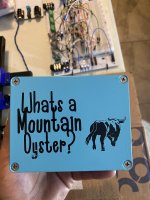Based on Tayda‘s description, you have. They list the screw as 7 x .8 mm (pitch), but without getting mu calipers out and finding a screw, that doesn’t make sense, it’s probably a #2 metric.
Before you even mount a tap into the holder, you can try screwing it down into the shallow tapped hole—if it doesn’t screw in, you will need a different size.
But the other issue, besides the correct thread size, is the type of tap. Hand tapping is almost always with tapered taps—these start to cut threads by cutting very finely, then taking out more and more as they are screwed in. But this means that there is a longer part of the tap tip that can’t cut threads in a “blind hole”, which is what enclosure screw holes are, meaning that they don’t go all the way through. So, you may need a “bottoming, or plug” type tap, which does not taper, since it is designed to be used after there are started threads.
Since I’m on a roll, the procedure for hand tapping is to back up 1/2 turn for every forward turn, once you are cutting threads. This clears out the cuttings, that would jamb the teeth of the tap. Before you tap a hole, rub the teeth of the tap (just need to do this on one side) on a bar of soap, to act as a lubricant. The aluminum boxes are both very soft, and very “loose” (meaning that the cast metal flakes off of tools easily, which is shy drilling and tapping are so easy).
Also, note that you really only need 2 or 3 threads worth of bite in an enclosure screw, so the option of cutting screws may be more appealing if you dont have the correct tap. Just make sure that there is no burr on the cut end—this will try to cut new “threads” in the hole, making a real mess of it. One trick is to put a nut on the screw, up above where you’ll cut it, and then, but removing the nut, you clean the burr off the tip.



